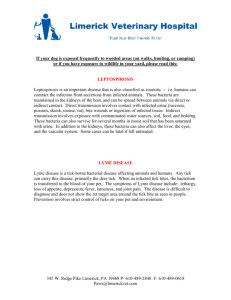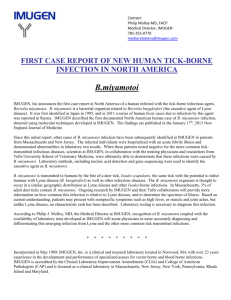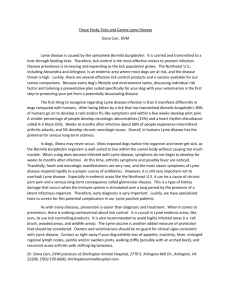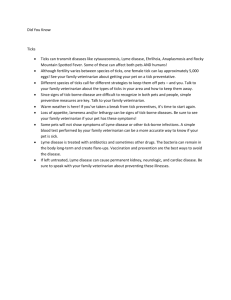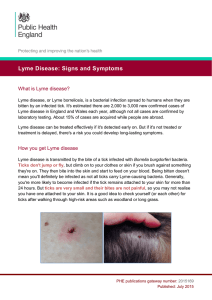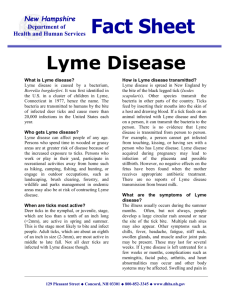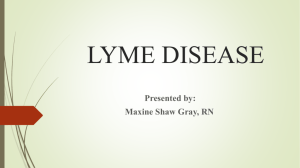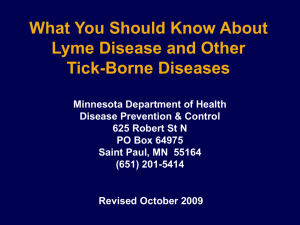Medical Encyclopedia: Lyme disease
advertisement
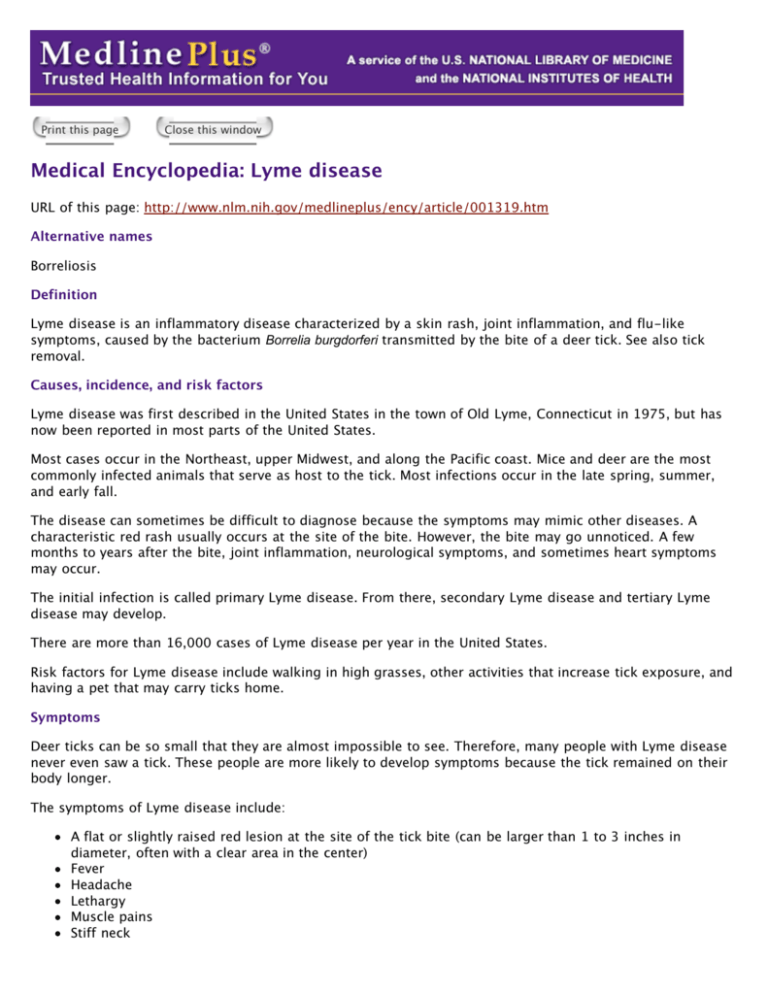
Print this page Close this window Medical Encyclopedia: Lyme disease URL of this page: http://www.nlm.nih.gov/medlineplus/ency/article/001319.htm Alternative names Borreliosis Definition Lyme disease is an inflammatory disease characterized by a skin rash, joint inflammation, and flu-like symptoms, caused by the bacterium Borrelia burgdorferi transmitted by the bite of a deer tick. See also tick removal. Causes, incidence, and risk factors Lyme disease was first described in the United States in the town of Old Lyme, Connecticut in 1975, but has now been reported in most parts of the United States. Most cases occur in the Northeast, upper Midwest, and along the Pacific coast. Mice and deer are the most commonly infected animals that serve as host to the tick. Most infections occur in the late spring, summer, and early fall. The disease can sometimes be difficult to diagnose because the symptoms may mimic other diseases. A characteristic red rash usually occurs at the site of the bite. However, the bite may go unnoticed. A few months to years after the bite, joint inflammation, neurological symptoms, and sometimes heart symptoms may occur. The initial infection is called primary Lyme disease. From there, secondary Lyme disease and tertiary Lyme disease may develop. There are more than 16,000 cases of Lyme disease per year in the United States. Risk factors for Lyme disease include walking in high grasses, other activities that increase tick exposure, and having a pet that may carry ticks home. Symptoms Deer ticks can be so small that they are almost impossible to see. Therefore, many people with Lyme disease never even saw a tick. These people are more likely to develop symptoms because the tick remained on their body longer. The symptoms of Lyme disease include: A flat or slightly raised red lesion at the site of the tick bite (can be larger than 1 to 3 inches in diameter, often with a clear area in the center) Fever Headache Lethargy Muscle pains Stiff neck Joint inflammation in the knees and other large joints Additional symptoms that may be associated with this disease: Itching, overall unusual or strange behavior Signs and tests Physical examination in advanced Lyme disease may show evidence of joint, heart, or brain abnormalities Antibodies to Borrelia burgdorferi by immunofluorescence (IFA) or ELISA. ELISA tests are confirmed with a Western blot test. Treatment Antibiotics are prescribed based on disease stages and manifestations. Doxycycline, tetracycline, cefuroxime, ceftriaxone, and penicillin are some of the choices. Anti-inflammatory medications, such as ibuprofen, are sometimes prescribed to relieve joint stiffness. Note: Doxycycline is usually not prescribed for children until after all the permanent teeth have erupted. It can permanently discolor teeth that are still forming. Expectations (prognosis) If diagnosed in the early stages, the disease can be cured with antibiotics. If left untreated, complications involving joints, the heart, and the nervous system can occur. Complications Secondary Lyme disease Tertiary Lyme disease Calling your health care provider Call your health care provider if symptoms of Lyme disease develop. Prevention When walking or hiking in wooded or grassy areas, tuck long pants into socks to protect the legs, and wear shoes and long-sleeved shirts. Ticks will show up on white or light colors better than dark colors, making them easier to remove from your clothing. Spray your clothes with insect repellant. Check yourself and your pets frequently. If you find ticks, remove them immediately by using tweezers, pulling carefully and steadily. Ticks can be fairly large -- about the size of a pencil eraser -- or so small that they are almost impossible to see. After returning home, remove your clothes and thoroughly inspect all skin surface areas, including your scalp. Ticks can quickly climb up the length of your body. Some ticks are large and easy to locate. Other ticks can be quite small, so carefully evaluate all spots on the skin. Update Date: 6/15/2005 Updated by: Monica Gandhi, MD, MPH, Assistant Professor, Division of Infectious Diseases, UCSF, San Francisco, CA. Review provided by VeriMed Healthcare Network. A.D.A.M., Inc. is accredited by URAC, also known as the American Accreditation HealthCare Commission (www.urac.org). URAC's accreditation program is the first of its kind, requiring compliance with 53 standards of quality and accountability, verified by independent audit. A.D.A.M. is among the first to achieve this important distinction for online health information and services. Learn more about A.D.A.M.'s editorial process. A.D.A.M. is also a founding member of Hi-Ethics (www.hiethics.com) and subscribes to the principles of the Health on the Net Foundation (www.hon.ch). The information provided should not be used during any medical emergency or for the diagnosis or treatment of any medical condition. A licensed physician should be consulted for diagnosis and treatment of any and all medical conditions. Call 911 for all medical emergencies. Adam makes no representation or warranty regarding the accuracy, reliability, completeness, currentness, or timeliness of the content, text or graphics. Links to other sites are provided for information only -- they do not constitute endorsements of those other sites. Copyright 2005, A.D.A.M., Inc. Any duplication or distribution of the information contained herein is strictly prohibited.

